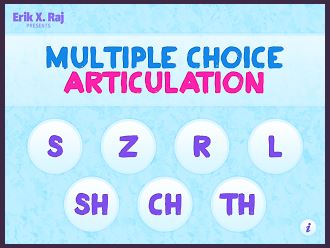App Review of the Week: Multiple Choice Articulation
by Danielle Reed
To say that artic therapy can get bland quickly would be an understatement! I am constantly wracking my brain trying to find a new and fun way to target sentence and conversation levels. Particularly for my oh-so-cool 3rd and 4th graders!
So, when I was offered the opportunity to try out Erik X. Raj’s Multiple Choice Articulation app, I was very excited to check it out! (maybe even giddy… I like apps & they like me) Erik is a fellow Speech-Language Pathologist who offers some great documents, tips, tricks, and information over at his website. The app (for iPad/iPad mini/iPhone/iPod touch) has over 500 silly and thought-provoking multiple choice questions targeting S, Z, R, L, S/R/L Blends, SH, CH, and TH.
Overall, we had a blast checking out this app in my speech room! Here are some specifics:
When you open up the app, you are presented with this screen. Included in the app are these 7 phonemes. Selecting the “i” will take you to more information and directions, contact information, etc. Just select the phoneme you will be working on during your session. You may only choose 1 at a time.
The phonemes are then broken down by position (including blends when appropriate). Again, you may choose just one at a time but this is a fairly quick step and I switch between phonemes and/or positions a few times during sessions if necessary.
So, is this self-proclaimed straightforward app right for your iTherapy? Only you can decide that, of course. But, here are my pros and cons could-be-betters about the Multiple Choice Articulation App:
Pros:
- Super easy to use. Children can even use it independently.
- For readers and non-readers
- Includes 7 phonemes with all positions for sounds that are often still seen in error in children.
- Insanely fun. I might laugh more when using this app than my students! May also cause laugh-snorts!
- Perfect for practice at the conversational level – students forget that they are practicing their sounds in this unscripted Q&A format which allows for accurate information regarding carry-over abilities.
- Also targets various language skills associated with answering questions and naming reasons behind a decision.
- Plenty of questions to allow for multiple uses of the app without repetition of questions.
- Road-tested with 4th and 5th graders: They enjoyed it as it wasn’t a “baby”ish app.
Could-Be-Betters:
- I’m a sucker for in-app tracking but I’m not sure how much that would really add to the app…
- It would be great to be able to add students and assign phonemes to them to practice. In a group with multiple students, each student would have personalized phonemes and positions on their turn.
- Some of the questions may be a little gag-inducing – but to be fair we loved those gross ones so maybe that’s more of a pro…
- You must be okay with being silly in therapy with your students when using this app… absolutely no stick-in-the-muds allowed!
To learn a little more about the app, a video demonstration and more information can be found here.
Featured Guest Columnist: Danielle Reed of Sublime Speech:
Danielle Reed, M.S., CCC-SLP is a Speech-Language Pathologist in Kansas City, Missouri. Since graduating from Missouri State University, she has gained experience working with children including those with severe and multiple disabilities, autism spectrum disorders, and speech and language disorders. She has a passion for Augmentative and Alternative Communication and creativity within the therapy environment. Danielle is the author of “Sublime Speech”, a blog for therapists and parents. In addition to working as a speech-language pathologist, Danielle enjoys coaching softball, traveling, and photography.
Please Support our Contributors and visit Sublime Speech!
PediaStaff is Hiring!
All JobsPediaStaff hires pediatric and school-based professionals nationwide for contract assignments of 2 to 12 months. We also help clinics, hospitals, schools, and home health agencies to find and hire these professionals directly. We work with Speech-Language Pathologists, Occupational and Physical Therapists, School Psychologists, and others in pediatric therapy and education.

